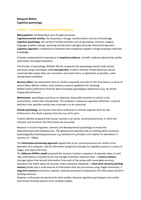Samenvatting
0HV60 Samenvatting Cognitive Psychology (Matlin)
- Instelling
- Technische Universiteit Eindhoven (TUE)
- Boek
- Cognitive Psychology
Deze samenvatting bevat de informatie uit de hoofdstukken 1 t/m 12 (only deductive reasoning) die geleerd moeten worden voor het 0HV60 tentamen. De dik gedrukte woorden zijn de begrippen uit het boek. Deze zijn allen vermeld inclusief de definitie. Verder is hier en daar wat extra informatie uit de...
[Meer zien]














